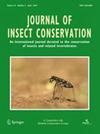地方性不会飞的灌木蟋蟀的运动模式
IF 1.9
3区 农林科学
Q2 ENTOMOLOGY
引用次数: 0
摘要
摘要:了解濒危物种的流动性是了解种群动态的线索,也是制定适当的保护策略的必要条件。在这里,我们研究了贝比延科丰满灌木蟋蟀(Isophya beybienkoi)的运动模式,这是斯洛伐克喀斯特(中欧斯洛伐克南部)特有的一种不会飞的极度濒危物种。采用捕获-标记-再捕获法,以荧光染料作为标记介质,估计物种的流动性。结果表明,该物种的平均日传播距离(±SD)仅为3.2±2.6 m,雌雄差异显著(4.1±3.0 m),表明其是一种短距离分散动物。雄性比雌性消失得更快(最多有两只雌性在41天后被重新捕获)。观察到的移动模式表明,最紧迫的保护措施是改善过度生长的生境质量,并保持其他可能增加现有亚种群规模的适宜生境的质量。我们的研究结果表明,北bienkoi是一个短距离的分散者,只在其最佳栖息地内徘徊。因此,为了将迁徙行为纳入保护,减轻这种威胁的措施之一是保护或改善遭受过度生长的栖息地的质量,以增加现有亚种群的规模。观察到的移动模式表明,该物种可能无法通过分散来应对适宜栖息地的变化,这表明孤立种群之间的个体交换有限。因此,为了提高高质量栖息地的结构多样性,恢复以前用作放牧动物运动走廊的迁徙走廊可能会支持受威胁的灌木蟋蟀的扩散。本文章由计算机程序翻译,如有差异,请以英文原文为准。
Movement patterns of the endemic flightless bush-cricket, Isophya beybienkoi
Abstract Introduction Knowledge on the mobility of threatened species is a clue to understanding population dynamics and is needed to develop appropriate conservation strategies. Here, we investigate movement patterns of the Bei-Bienko’s Plump Bush-cricket ( Isophya beybienkoi ), an example of a flightless and critically endangered species endemic to the Slovak Karst (southern Slovakia, Central Europe). The capture-mark-recapture method was used to estimate the mobility of the species using fluorescent dye as a marking medium. We found that the mean (± SD) daily distance travelled by this species was only 3.2 ± 2.6 m, with significant differences between males (4.1 ± 3.0 m) and females (2.7 ± 2.1 m). Our results indicate that I. beybienkoi is a short-distance disperser. Males disappeared faster than females from the study plots (at maximum, two females were recaptured even after 41 days). The observed movement patterns suggest that the most urgent conservation measure for this species is to improve the habitat quality of sites, which suffer from overgrowth, and to maintain the quality of other suitable sites that might increase the size of the existing subpopulations. Implications for insect conservation Our results show that I. beybienkoi is a short-distance disperser and wanders only within its optimal habitat. Hence, to incorporate movement behaviour into conservation, one of the measures that should mitigate this threat is to preserve or improve the quality of habitats that suffer from overgrowth, in order to increase the size of existing subpopulations. The observed movement patterns suggest that the species is probably incapable of responding to changes in the availability of suitable habitats by dispersing, indicating a limited exchange of individuals between isolated populations. Thus, to enhance structurally diverse mosaic of high-quality habitats, restoration of migration corridors former used as movement corridors for grazing animals may support the dispersal of the threatened bush-cricket.
求助全文
通过发布文献求助,成功后即可免费获取论文全文。
去求助
来源期刊
CiteScore
3.60
自引率
10.50%
发文量
76
审稿时长
6 months
期刊介绍:
The Journal of Insect Conservation is an international journal devoted to the publication of articles concerned with the conservation of insects and related invertebrates. The Journal of Insect Conservation publishes papers on all aspects of conservation and biodiversity related to the insects and closely related groups such as Arachnids and Myriapods, including ecological work which has conservation implications. Research papers may address the subject at the community, population or species level, may cover aspects of behaviour, taxonomy or genetics, be theoretical or practical, and be local or global in nature. Review articles are welcome as well as points of view which are likely to stimulate debate. From time to time the journal will publish Special Issues on specific subject areas which are the focus of current research. Proposals for such issues are welcome.

 求助内容:
求助内容: 应助结果提醒方式:
应助结果提醒方式:


